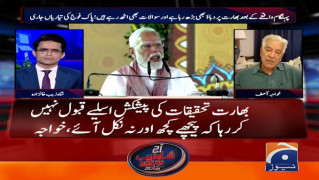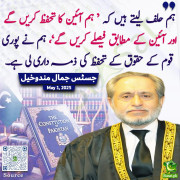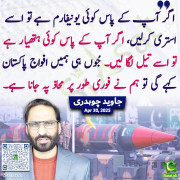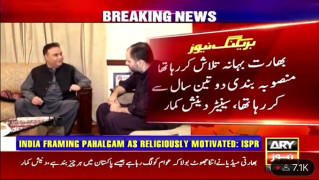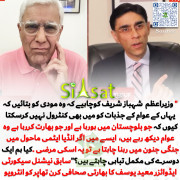
We teach Urdu in America. We learned we can’t use Pakistani textbooks
With outdated techniques and racist content, Pakistani textbooks are unfit for a multi-religious but secular classroom.
Asma Begum | Mushtaq Bilal
After we arrived in upstate New York in the fall of 2017 as cultural exchange visitors, we kept thinking about how to introduce the people here to some aspects of Pakistani culture.
We kept bouncing ideas off each other: maybe start an Airbnb Experience that focuses on Pakistani cuisine, or maybe suggest the local public library to acquire more books on Pakistani culture and start a Pakistan-focused reading group.
After a few discussions, we realised that one of the best ways of introducing some aspects of Pakistani culture here could be to introduce an Urdu language programme at the local university, the State University of New York (SUNY) at Binghamton.
We approached the dean of the Department of Asian and Asian American Studies (DAAAS) and pitched a beginner-level Urdu language programme. The dean really liked the idea because the language programmes at the DAAAS were limited to languages like Chinese, Japanese and Korean.
Since one of us (Mushtaq) was busy with his doctoral course work, we decided that it would be best if Asma taught Urdu. The dean asked us to submit a detailed course outline and a proposed syllabus.
After 100 or so hours of reading through various textbooks, discussing different pedagogical models and fighting over what to include and what not, we came up with a presentable course outline and syllabus.
The dean liked the course materials and registration for Elementary Urdu 1 started in the fall of 2018 with the course due to start in the spring of 2019.
We had brought with us elementary-level Urdu textbooks from Pakistan to teach our son. These textbooks are published by one of the leading academic publishers in the country and the school our son attended in Pakistan had used the same series of textbooks.
In our naiveté, we thought we would be able to appropriate the content from these Pakistani textbooks to teach Urdu here in America.
The first thing we realised was these textbooks had been written to teach Urdu to learners who spoke Urdu as a native language. Appropriating the content of these textbooks to teach Urdu as a foreign language became a tricky and unrewarding task.
The second issue is the kind of content these Pakistani textbooks have. The majority of the content is overly religious and ideological and it is extremely difficult, if not downright impossible, to appropriate it to suit a multi-religious but secular classroom in an American university.
The third, and probably the most important, issue is that these textbooks contain content that is blatantly racist. For example, in a textbook for second grade, students are asked to practise reading and writing kala chor (black thief).
Neither of us noticed this until our son asked us, “Don’t you think it’s racist?” We agreed and thanked him for bringing this to our attention.
The issue of the racist content is all the more important because these textbooks are published by a multinational publisher which claims to be the largest university press in the world, not a provincial textbook board.
That elementary-level textbooks contain racist content might explain why so many Pakistanis found Pakistan’s cricket captain Sarfaraz Ahmed’s racist comment to South African player Andile Phehlukwayo perfectly 'normal.'
Critical and overlooked
The US Department of State considers the learning and teaching of Urdu “critical to national and economic prosperity of America.” Urdu is considered one of the “critical languages” included in the Critical Language Scholarship (CLS) programme funded by the Department of State.
The CLS programme sends American students desirous of learning Urdu to Lucknow, India. Unfortunately, American students are not sent to Pakistan to study Urdu because the Department of State advises Americans to “reconsider” travelling to Pakistan.
Most Urdu language programmes in American universities are run and staffed by scholars who are either Indian or of Indian origin. There are, of course, American specialists of Urdu like Frances W. Pritchett working in American academia.
The Institute of South Asia Studies at the University of California, Berkeley, offers an Urdu language immersion programme at the Lahore University of Management Sciences (Lums). Unlike the CLS programme, which is funded and sponsored by the Department of State, the Lums immersion programme costs $7,900 in addition to travel and visa expenses, unless one has a fellowship.
Urdu is offered at several American universities including Harvard, Brown, Princeton, universities of Chicago and Wisconsin-Madison and New York University.The University of Texas at Austin runs the Hindi Urdu Flagship (HUF) programme for undergraduate students who wish to achieve advanced proficiency in Urdu. The HUF also sends American students to India for immersion language study of Urdu.
Absent scholars
Pakistani scholars are conspicuous by their absence as far as the pedagogical landscape of Urdu in American academia is concerned. There are, of course, a few exceptions to this, but exceptions are just that — exceptions.
Most Urdu language textbooks being used in American classrooms are written either by scholars of Indian origin or are collaborative efforts of American and Indian-origin scholars.We are yet to come across any authoritative textbook of Urdu as a foreign language written by a Pakistani scholar.
We would be grateful if readers of this piece could point us towards any authentic textbook of Urdu meant for foreign language learners written by a Pakistani scholar.
We are not sure about the reasons for the absence of Pakistani scholars as far as teaching of Urdu as a foreign language is concerned, at least here in American academia.
A probable reason could be that Pakistani scholars are not aware of the fact that there is considerable interest in learning Urdu as a foreign language in America.
Another reason could be the lack of proficiency in English among Pakistani specialists of Urdu. One rarely comes across a specialist of Urdu in Pakistan who is proficient enough in English to write a textbook meant for foreign learners of Urdu.
The textbooks that are being used in American classrooms to teach Urdu as a foreign language have their own pedagogical challenges and shortcomings.
For example, a textbook that we are also using at SUNY Binghamton uses both nastaliq and naskh fonts, which makes it difficult for beginner-level learners to remember the full and truncated forms of the Urdu alphabet and gives rise to unnecessary confusion.
Another textbook that uses a companion volume for teaching the Urdu script starts with exercises and practice drills that a beginner-level student of Urdu might find overly intimidating.
Both these textbooks are over 500 pages long, which makes them unwieldy for students to carry around.Compared to the textbooks of Urdu available here, some of the textbooks of Arabic and Chinese that we have come across employ latest pedagogical techniques, are far better organised and make the process of acquiring a foreign language very efficient for students.
The interest is already there
When we started the Urdu language programme at SUNY Binghamton, the dean of the DAAAS told us that he would only be able to run the programme if at least 10 students registered for the course.By the start of the semester 15 students had registered, which included both heritage and non-heritage students.
In foreign language pedagogy, students who have had any exposure to a target language through their family are considered heritage students, while those who have never had any exposure to a target language are considered non-heritage students.
Since there is a sizeable South Asian community here in the greater Binghamton area, we had assumed that our Urdu course would appeal only to heritage students.
Surprisingly, a considerable number of non-heritage students also enrolled for Elementary Urdu 1.
In terms of teaching, heritage students pose a different sort of challenge when compared to non-heritage students because while non-heritage students come to the class without any knowledge of Urdu, heritage students have a certain level of knowledge about the language, but this level of proficiency might not be even.
Some heritage students might know how to speak Urdu, but they wouldn’t know how to write it, while others could understand the language (due to constant exposure to Bollywood movies) but couldn’t speak it.
Halfway through the semester, almost all students in Elementary Urdu 1 are able to write and identify the Urdu alphabet and the various truncated forms of Urdu letters.
Mastering the Urdu alphabet might not seem like a big deal to Pakistani speakers of Urdu, but it poses considerable challenges for non-native learners of the language.
The students are able to introduce themselves in Urdu and hold a small conversation among themselves. They can also count from one to 10.
By the end of the semester, the students will hopefully have mastered the basics of Urdu and will be able to engage in simple daily-life conversations with native speakers, read simple written texts and write a brief paragraph about a familiar topic.
Our aim is to continue with Elementary Urdu 1 in the fall semester, and if things go according to plan, introduce Elementary Urdu II in the spring of next year.
The Urdu programme is our humble contribution to the cultural diversity at SUNY Binghamton and a modest attempt at reciprocating the generosity of the Fulbright cultural exchange programme.
- Featured Thumbs
- https://i.dawn.com/primary/2019/04/5cb58f0b5a65f.jpg
Last edited by a moderator:


